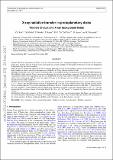X-ray radiative transfer in protoplanetary disks : The role of dust and X-ray background fields
Abstract
Context. The X-ray luminosities of T Tauri stars are about two to four orders of magnitude higher than the luminosity of the contemporary Sun. As these stars are born in clusters, their disks are not only irradiated by their parent star but also by an X-ray background field produced by the cluster members. Aims. We aim to quantify the impact of X-ray background fields produced by young embedded clusters on the chemical structure of disks. Further, we want to investigate the importance of the dust for X-ray radiative transfer in disks. Methods. We present a new X-ray radiative transfer module for the radiation thermo-chemical disk code PRODIMO (PROtoplanetary DIsk MOdel), which includes X-ray scattering and absorption by both the gas and dust component. The X-ray dust opacities can be calculated for various dust compositions and dust-size distributions. For the X-ray radiative transfer we consider irradiation by the star and by X-ray background fields. To study the impact of X-rays on the chemical structure of disks we use the well established disk ionization tracers N2H+ and HCO+. Results. For evolved dust populations (e.g. grain growth), X-ray opacities are mostly dominated by the gas; only for photon energies E greater than or similar to 5—10 keV do dust opacities become relevant. Consequently the local disk X-ray radiation field is only affected in dense regions close to the disk midplane. X-ray background fields can dominate the local X-ray disk ionization rate for disk radii r greater than or similar to 20 au. However, the N2H+ and HCO+ column densities are only significantly affected in cases of low cosmic-ray ionization rates (less than or similar to 10-19 s-1), or if the background flux is at least a factor of ten higher than the flux level of ≈ 10-5 erg cm-2 s-1 expected for clusters typical for the solar vicinity. Conclusions. Observable signatures of X-ray background fields in low-mass star-formation regions, like Taurus, are only expected for cluster members experiencing a strong X-ray background field (e.g. due to their location within the cluster). For the majority of the cluster members, the X-ray background field has relatively little impact on the disk chemical structure.
Citation
Rab , C , Güdel , M , Woitke , P , Kamp , I , Thi , W-F , Min , M , Aresu , G & Meijerink , R 2018 , ' X-ray radiative transfer in protoplanetary disks : The role of dust and X-ray background fields ' , Astronomy & Astrophysics , vol. 609 , A91 . https://doi.org/10.1051/0004-6361/201731443
Publication
Astronomy & Astrophysics
Status
Peer reviewed
ISSN
1432-0746Type
Journal article
Description
The research leading to these results has received funding from the European Union Seventh Framework Programme FP7-2011 under grant agreement no 284405. CHR and MG acknowledge funding by the Austrian Science Fund (FWF): project number P24790. The computational results presented have been achieved using the Vienna Scientific Cluster (VSC). This publication was supported by the Austrian Science Fund (FWF).Collections
Items in the St Andrews Research Repository are protected by copyright, with all rights reserved, unless otherwise indicated.

